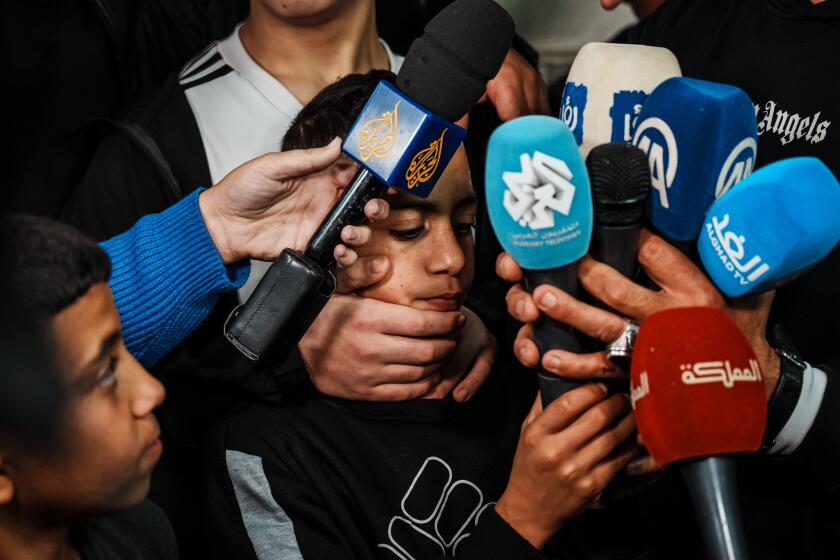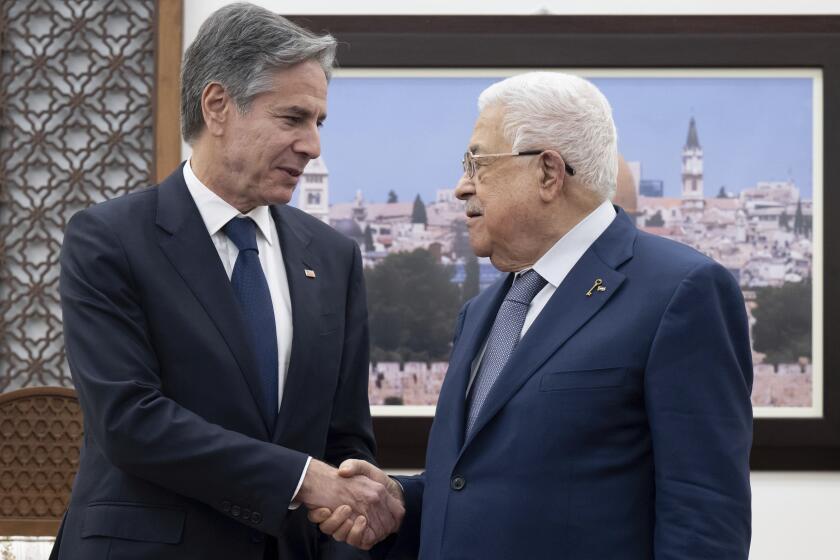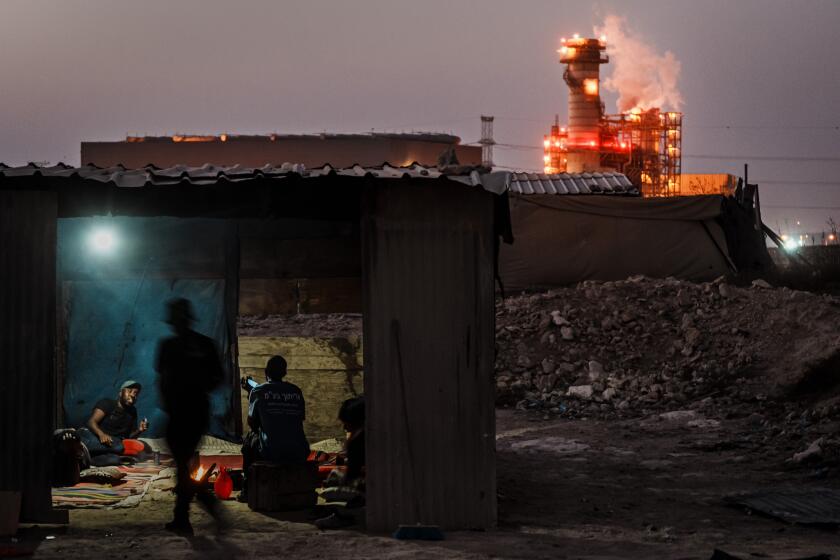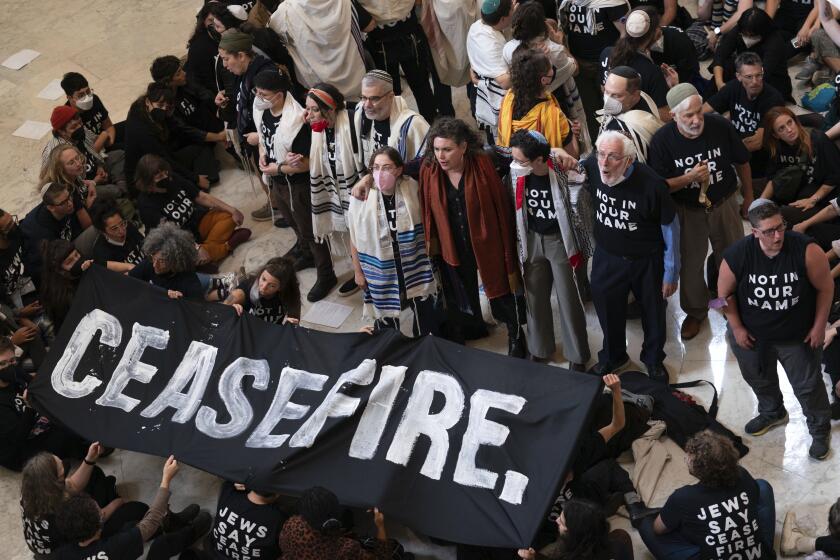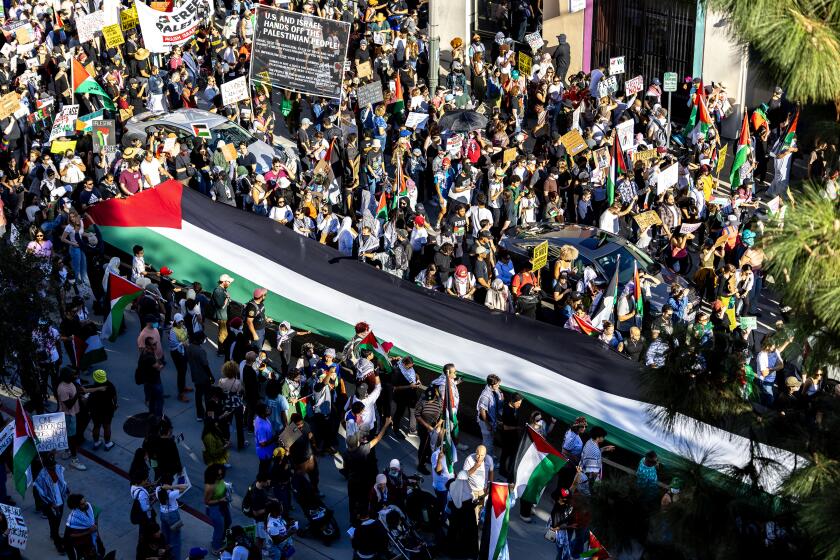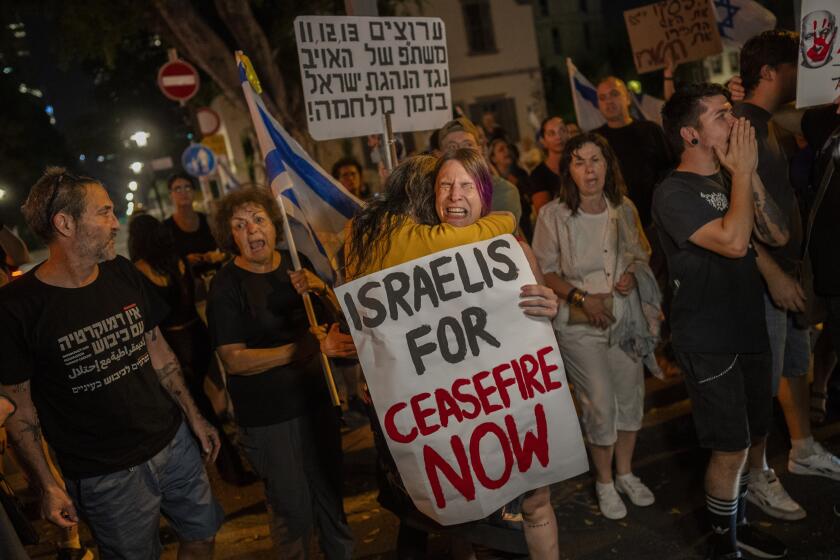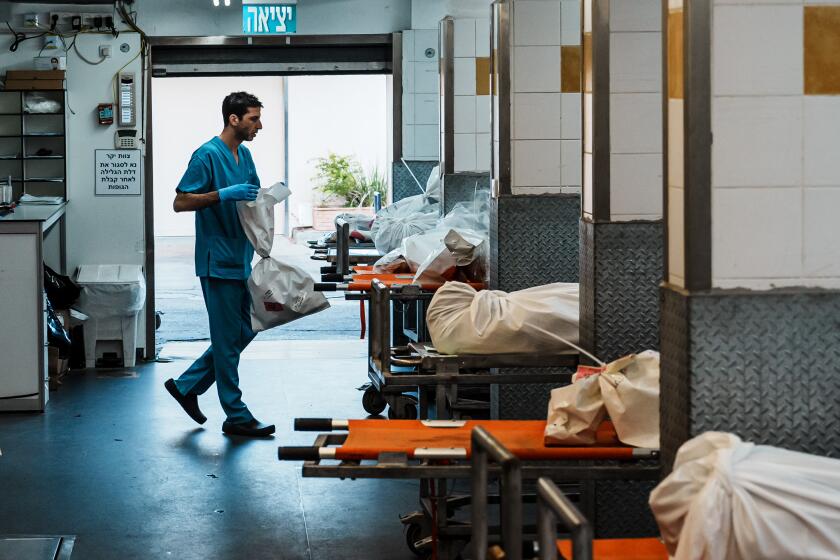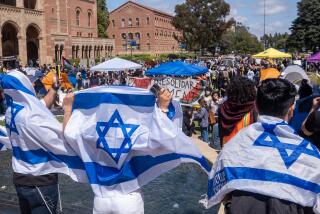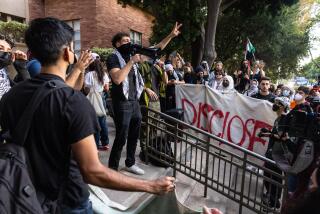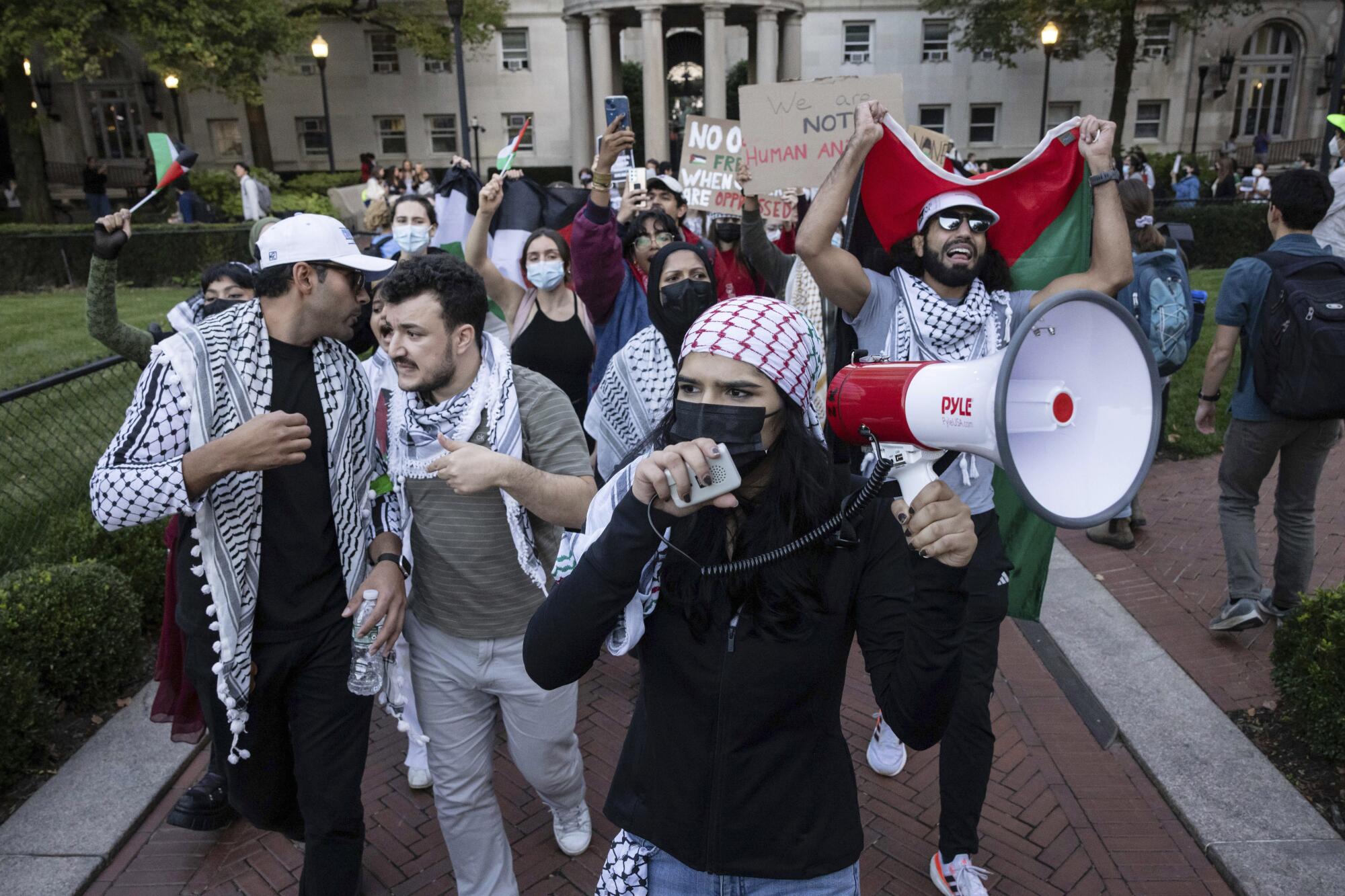
- Share via
The Student Nonviolent Coordinating Committee was best known for its sit-ins against segregation in the Deep South. But in the summer of 1967, the civil rights group used its newsletter to weigh in on a different topic.
In an article headlined “The Palestine Problem,” the group wrote: “Do you know that Zionism, which is a world-wide nationalistic Jewish movement, organized, planned and created the ‘State of Israel’ by sending Jewish immigrants from Europe into Palestine (the heart of the Arab world) to take over land and homes belonging to the Arabs?”
It was illustrated with a dollar sign inside a Star of David. The story roiled many civil rights activists, who denounced it as antisemitic and expressed their support for Israel as a homeland for Jews in the wake of the Holocaust.
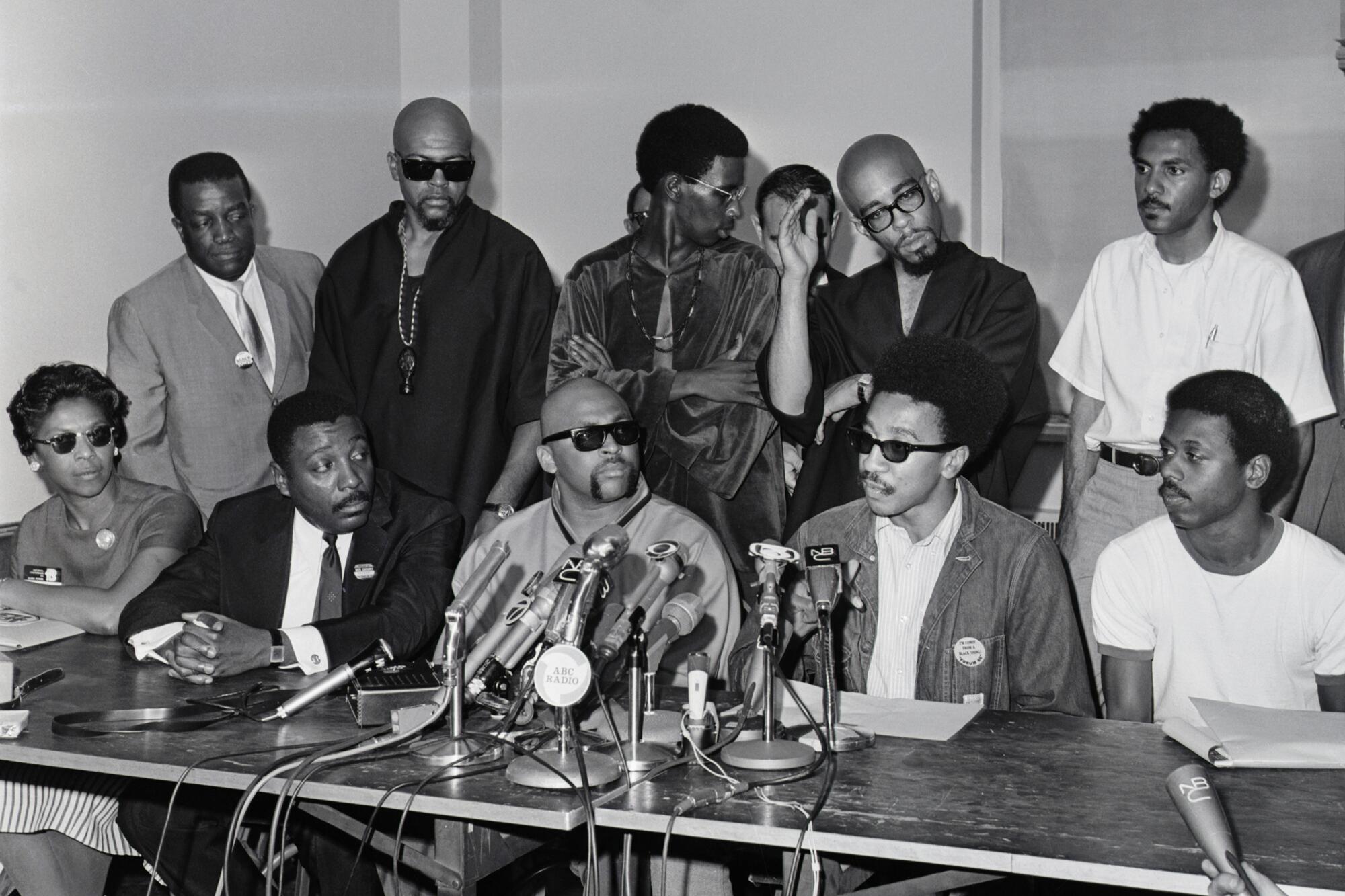
The SNCC, which had expelled white members as it shifted to a more radical Black nationalism, responded with an official statement that recognized the killing of 6 million Jews as “one of the worst crimes against humanity.” But then it argued: “We do not see how the Jewish refugees and survivors could ever use this tragedy as an excuse to imitate their Nazi oppressors.”
More than half a century later, the Palestinian cause — and hostility not only to Israeli policy but to the country’s very existence as a homeland for Jews — has shifted from the sidelines of student activism to become one of the most robust political movements on American college campuses.
The recent hostage-for-prisoner swaps between Hamas and Israel have focused attention on the number of Palestinian minors imprisoned by Israel.
Even before the current war between Israel and the militant group Hamas spurred an unprecedented wave of pro-Palestinian demonstrations, “Free Palestine” had become a rallying cry of student activists, many of whom roundly condemned Israel as a “settler colonialist” state.
The intellectual foundation for the movement emerged in the early 1960s as African nations were gaining independence from their European colonizers. Frantz Fanon, a psychiatrist and philosopher who worked in Algeria, famously wrote that resistance must be violent because it is the only “language” the colonizer speaks. His work inspired a new field of scholarship that would come to be known as postcolonial studies.
But the story of how the Palestinian cause took off on campuses involves much more than academic theories.
It’s a tale of careful planning by activists, dramatic political change in Israel and the rise of a U.S. social justice movement that homed in on race and other markers of identity and framed many of the world’s conflicts as a simple battle between two sides: the oppressors and the oppressed.
: :
For decades, the Palestinian struggle was a fringe cause in the United States — and most of the student activists were Palestinian.
That became a big problem in the early 1990s. During the Persian Gulf War, hundreds of thousands of Palestinians were evicted from Kuwait and left jobless. Fewer families could afford to send their children to U.S. colleges, seriously diminishing the ranks of students fighting for the cause.
Hatem Bazian, a Palestinian graduate student at UC Berkeley, was part of a small group that decided a new tack was needed. In the fall of 1993, just as the historic Oslo peace negotiations for a Palestinian state were about to start, he helped found the first chapter of Students for Justice in Palestine with the aim of forging alliances with non-Muslims.
Membership was open to anyone who supported ending Israeli occupation of the Palestinian territories, eliminating U.S. aid to Israel and allowing Palestinians to return to the homes they had lost when Israel became a state in 1948.
Many of those who joined had protested the Gulf War, the police beating of Rodney King in Los Angeles and the mistreatment of farmworkers.
The Biden administration views the two-state solution — an independent Palestinian state alongside Israel — as the only way to stop generations of violence.
“A coalition developed in the United States and in college campuses that made these links together,” recalled Bazian, now a 59-year-old lecturer in Middle Eastern languages and cultures and Asian American studies at Berkeley.
Momentum slowly built as peace negotiations dragged on and Israeli politics shifted to the right. In 1996, the same year Benjamin Netanyahu became prime minister, three Berkeley undergraduates formed Jewish Voice for Peace, which opposes Zionism, the movement to establish and protect a Jewish nation in what is now Israel.
At the same time, postcolonial studies were gaining traction on campuses — along with the view that Israel was a “settler colonial” state seeking to boot out the Palestinian population. It seemed every college student was reading the Palestinian American scholar Edward Said, who argued that Western writers, artists and scholars had created a widespread fallacy that the East was primitive and inferior.
The occupation of Gaza and the West Bank increasingly earned comparisons to the subjugation of the Black majority during apartheid-era South Africa.
By 2003, when Rashid Khalidi, a Palestinian American historian of the Middle East, arrived at Columbia University, the Oslo negotiations were long dead. Campus activism centered on the U.S.-led invasion of Iraq, a war that students condemned as racist, colonialist and imperialist.
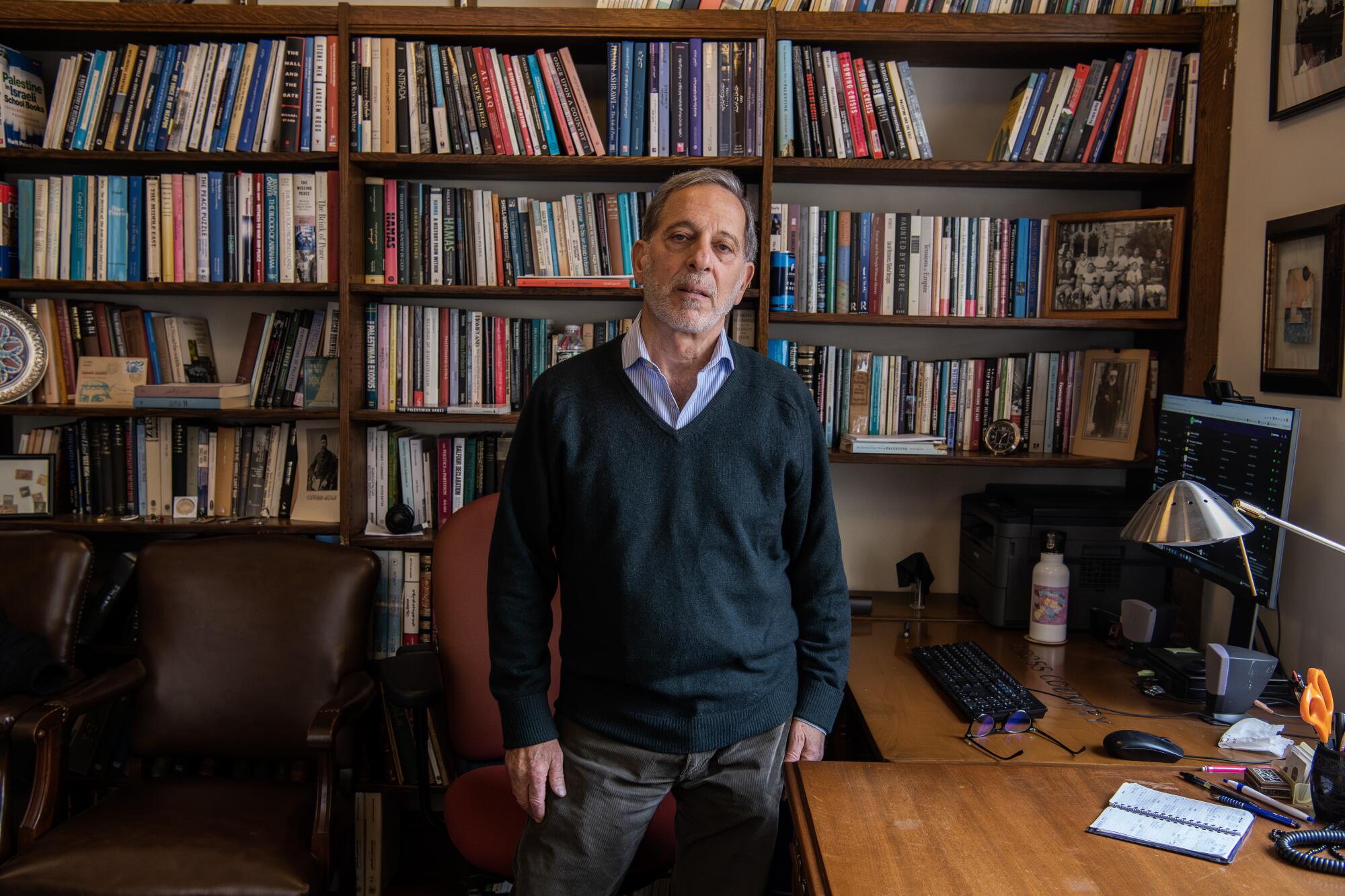
“There was no such consensus on Palestine,” Khalidi said.
But the issue was becoming charged. In 2004, the university launched an investigation after Jewish students accused several pro-Palestinian professors — Khalidi not among them — of teaching a one-sided view of the Israeli–Palestinian conflict and intimidating Jewish students. It cleared the professors of antisemitism but found one had “exceeded commonly accepted bounds” of behavior by shouting down a pro-Israeli student.
The fledgling movement to punish Israel economically with boycotts and divestment also became a rallying point for students. Few universities adopted such policies, but it wasn’t long before pro-Palestinian activists at Columbia and a growing number of other campuses were hosting “Israeli Apartheid Week.”
Bedouins of the Negev desert face rockets from Gaza and discrimination and arrest by Israel. They seek safety as the war energizes the far right.
The Anti-Defamation League grew concerned, warning in 2011 that more university departments were sponsoring “explicit anti-Israel events” and that Students for Justice in Palestine — which by then had at least 75 chapters — was becoming more organized and disrupting public meetings to silence pro-Israel views.
The Columbia chapter adopted an “anti-normalization” policy of refusing to take part in any events — including debates — that could “give a false picture of equality between the two parties by ignoring and legitimizing Israel’s oppression of the Palestinian people.”
By 2013, the editors of the socialist magazine Jacobin wrote: “Palestine is no longer a dirty word on college campuses.”
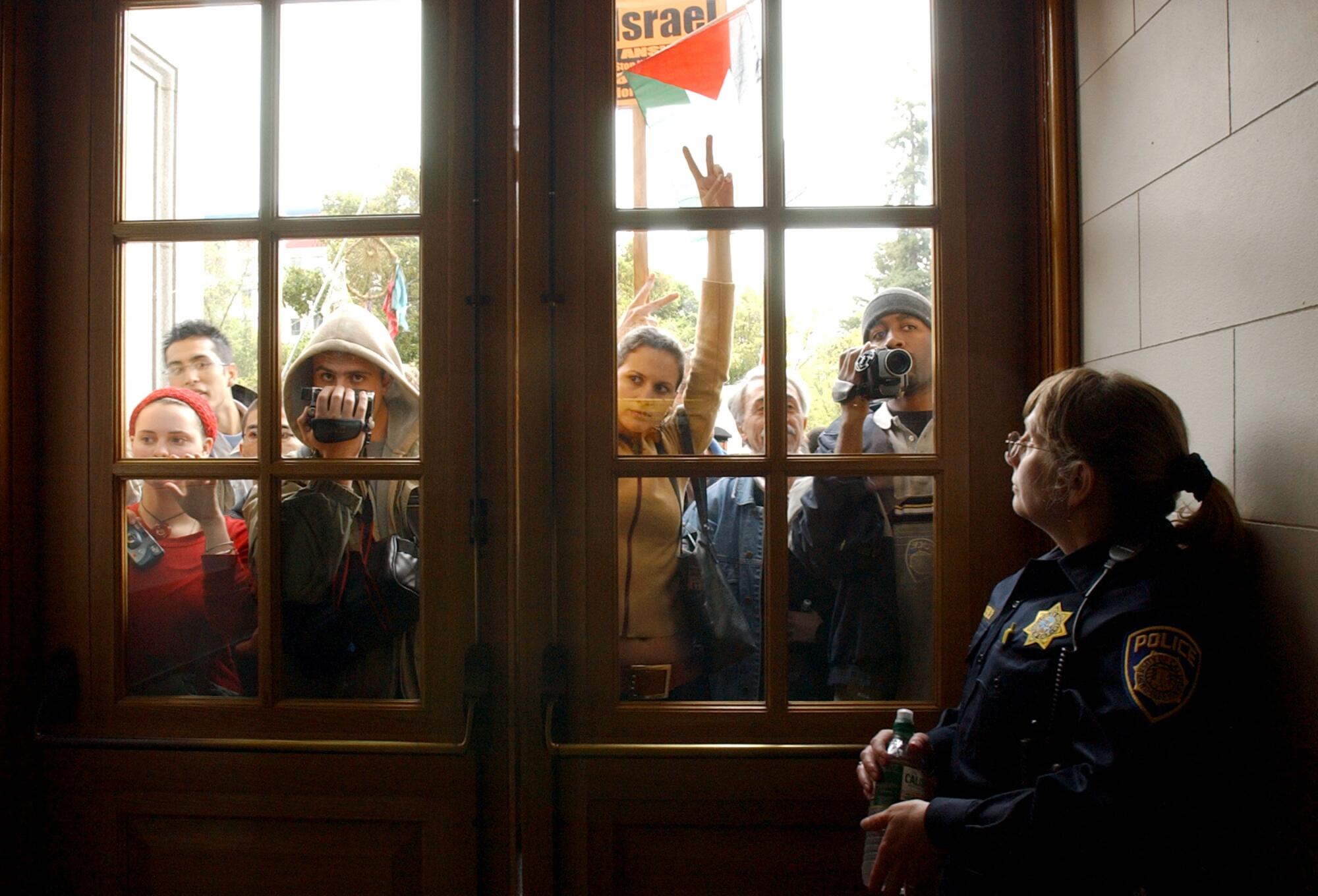
“Almost without anyone noticing,” they noted, “the movement in solidarity with Palestinian rights — with all its solipsisms and ultra-leftist foibles, its quarrels and magnetic attraction for eccentrics, opportunists, and, yes, the occasional antisemite — has grown to become one of the most important, inspiring, and fast-growing social movements in the country.”
: :
Among the students swept up in it was Kristian Davis Bailey. When he arrived at Stanford University in 2010, he knew nothing about Israel or Gaza.
His sophomore-year roommates, both pro-Palestinian activists, provided an introduction. They told him about a Palestinian alumnus who had been pepper-sprayed, arrested and detained at a protest in the West Bank.
Bailey wrote an article about it for the college newspaper. A few days later in Florida, a neighborhood watch volunteer named George Zimmerman shot and killed Trayvon Martin, an unarmed Black high school student walking home from a store.
Bailey, who is Black, suddenly found himself comparing the struggles of Black Americans and Palestinians. His major in ethnic studies offered a term that captured that connection: intersectionality. The concept was born in 1989 as a legal theory to describe how people experience discrimination in unique ways depending on race, gender, class and other identities, but has since been adopted by activists to lump together the oppression of various groups.
After connecting on social media with Palestinian activists, Bailey visited Gaza and the West Bank to see for himself how Palestinians lived.
‘Our human ask is that people give a damn when we die,’ said one rabbi. Amid the Israel-Hamas war, many U.S. Jews feel betrayed by people they thought were allies.
The checkpoints, the border walls, the Israeli settlements on land internationally recognized as belonging to Palestinians — Bailey struggled to understand Israel’s treatment of Palestinians or its reasoning that such measures were carried out in the interest of national security.
“I felt like I was watching some dystopian mash-up of the pass laws Blacks faced in apartheid South Africa and the cruel humiliation of the Jim Crow South,” he wrote in an article for Ebony magazine.
In fact, the two causes — the Palestinian struggle and the fight against racism in America — were becoming intertwined.
In the summer of 2014, a police officer in Ferguson, Mo., shot and killed Michael Brown, triggering nationwide protests and dramatically elevating the profile of Black Lives Matter. That coincided with a groundswell of international opposition to a 50-day war in Gaza. After Palestinian militants abducted and killed three Jewish teenagers in the West Bank, Israel killed more than 2,200 Palestinians.
“The same tear gas was being used in Ferguson as Palestine,” said Bailey, now 31. “We saw military tanks occupy St. Louis as they were being deployed in Gaza.”
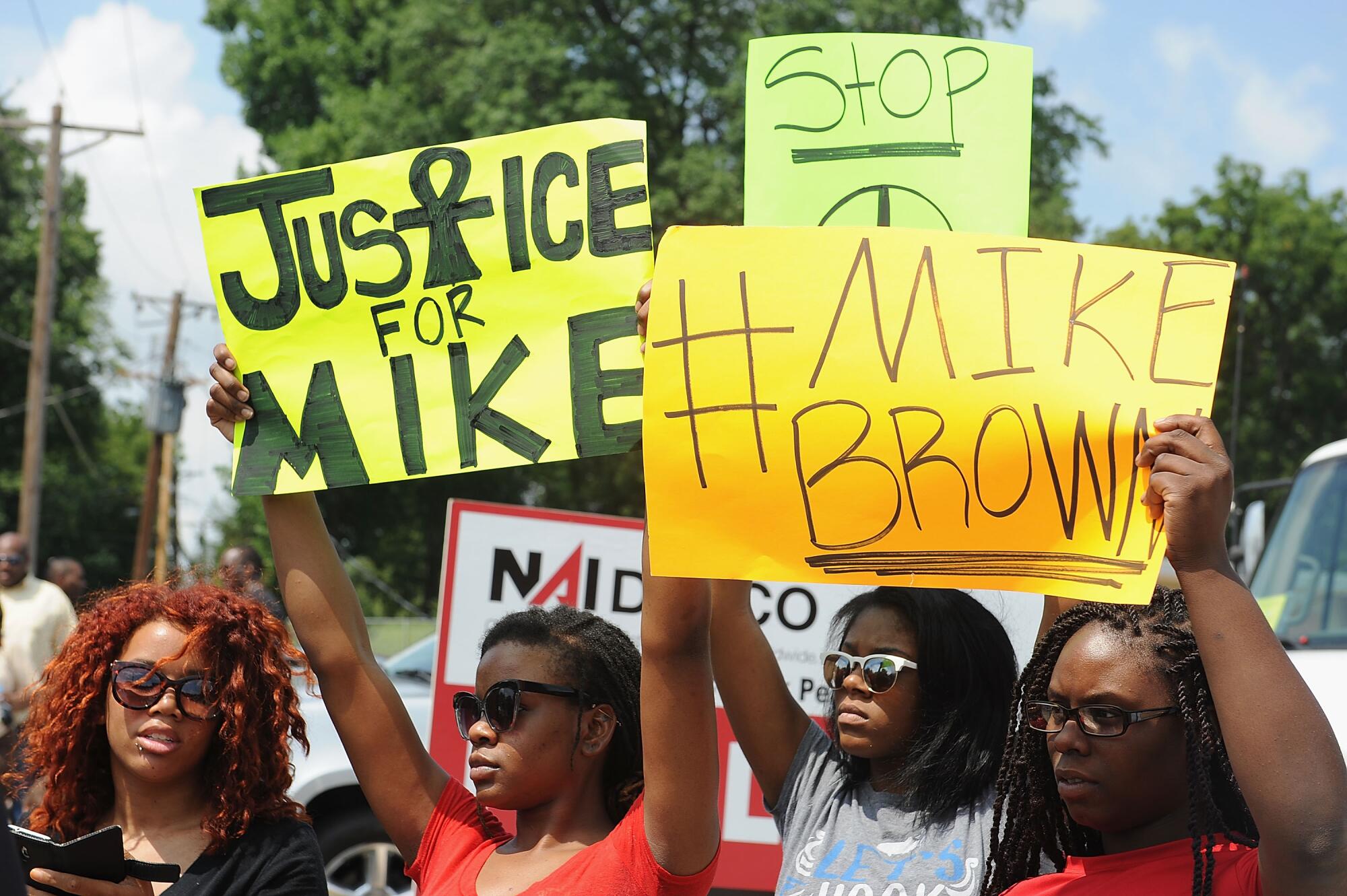
Activists in Gaza and Egypt took to Twitter to offer U.S. demonstrators practical advice on how to deal with tear gas. One Palestinian American activist, Bassem Masri, livestreamed daily protests from Ferguson.
“From Gaza to Ferguson” became a rallying cry that linked a generation of Black and Palestinian activists.
After Ferguson, Bailey said, Stanford’s Black Student Union and NAACP chapters, which had been tepid on the Palestinian issue, became leading advocates on campus for boycotting Israeli businesses.
In 2015, Stanford’s undergraduate senate voted to pass a resolution to “Divest from Companies Violating Human Rights in Occupied Palestine.”
Where are Israel-Hamas war protests growing and how are messages shifting? Here’s what the data on over 2,000 pro-Palestinian and pro-Israeli demonstrations say.
That same year, the National Women’s Studies Assn., the largest feminist U.S. academic group, voted to support the movement to divest, finding common cause with Palestinians in “the interconnectedness of systemic forms of oppression.”
At Columbia, a growing number of student groups — including Columbia Queer Alliance, GendeRevolution and Columbia Divest for Climate Justice — endorsed Columbia University Apartheid Divest, a coalition founded in 2016 that campaigns against “Israeli apartheid” and sees “Palestine as the vanguard of our collective liberation.”
On many campuses, Jewish students increasingly said it was almost impossible to be involved in activism — including LGBTQ+ and feminist causes — if they did not condemn Zionism. Some activist groups explicitly prohibited students who believe in Israel’s right to exist, even if they opposed Israel’s government and policies.
In 2020, when the police murder of George Floyd in May ignited mass demonstrations across the nation that continued through summer, protesters held up Palestinian black, white and green flags with red triangles. Growing numbers showed up wearing the traditional square checkered headscarf — known as a kaffiyeh — that has become a symbol of Palestinian nationalism.
At rallies against police violence and racism, abortion bans and anti-LGBTQ+ legislation, speakers took to the stage with another message: Free Palestine.
: :
Dov Waxman, a professor of political science and chair of Israel studies at UCLA, has always tried to challenge his students not to buy into simplified narratives about the Middle East.
He grew up with one. At the Orthodox Jewish boarding school he attended in England, Palestinians were routinely labeled terrorists or antisemites.
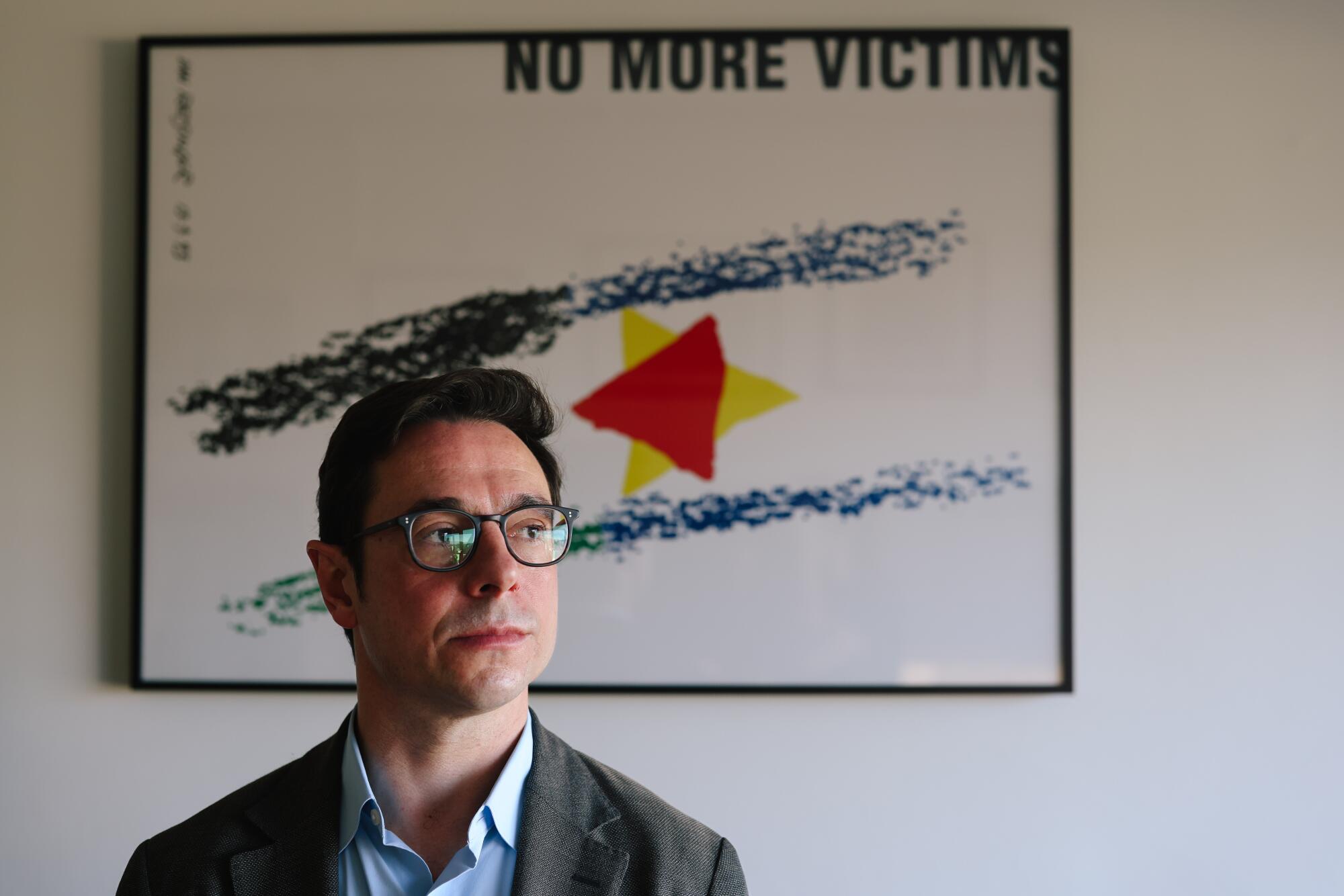
It wasn’t until graduate school in the late 1990s that Waxman was introduced to a Palestinian perspective on Israel — through the work of Edward Said.
“Up until Said, most people looked at Zionism through the lens of Jewish history ... understanding it as a liberation movement for Jews or as a response to the Holocaust,” Waxman said.
Said’s was a valuable perspective, but as new ways of thinking gained traction on campuses, Waxman began to worry that students were trading one orthodoxy for another.
The concept of settler colonialism accurately captured the way that many Jews who moved to Israel ignored or dismissed the local population and ultimately displaced many Palestinians, he said. But it missed the ways in which Zionists saw themselves as returning to their homeland after a long, forced exile.
A month after Hamas’ surprise attack nearly brought Israel to its knees, the country’s battered ‘peace camp’ is rising — or trying its best to do so.
Intersectionality could be a useful concept for exploring race and antisemitism, Waxman came to believe. But when understood simply as mapping the oppression of Black Americans on to the Palestinian cause and depicting Israelis as white, it ignored the fact that roughly half of Israeli Jews trace their origins to the Middle East or North Africa.
Still, he saw such thinking as an intellectual flaw — “and nothing more than that.”
Then came Oct. 7.
Hundreds of Hamas militants burst through a barrier from Gaza into southern Israel and slaughtered around 1,200 people at kibbutzes and a music festival. Many American Jews were startled to watch students and scholars at several elite colleges rush to justify and in some cases celebrate a massacre in which civilians were shot, stabbed and burned.
“This is what it means to Free Palestine,” the National Students for Justice in Palestine said in a statement the same day. “Not just slogans and rallies, but armed confrontation with the oppressors.”
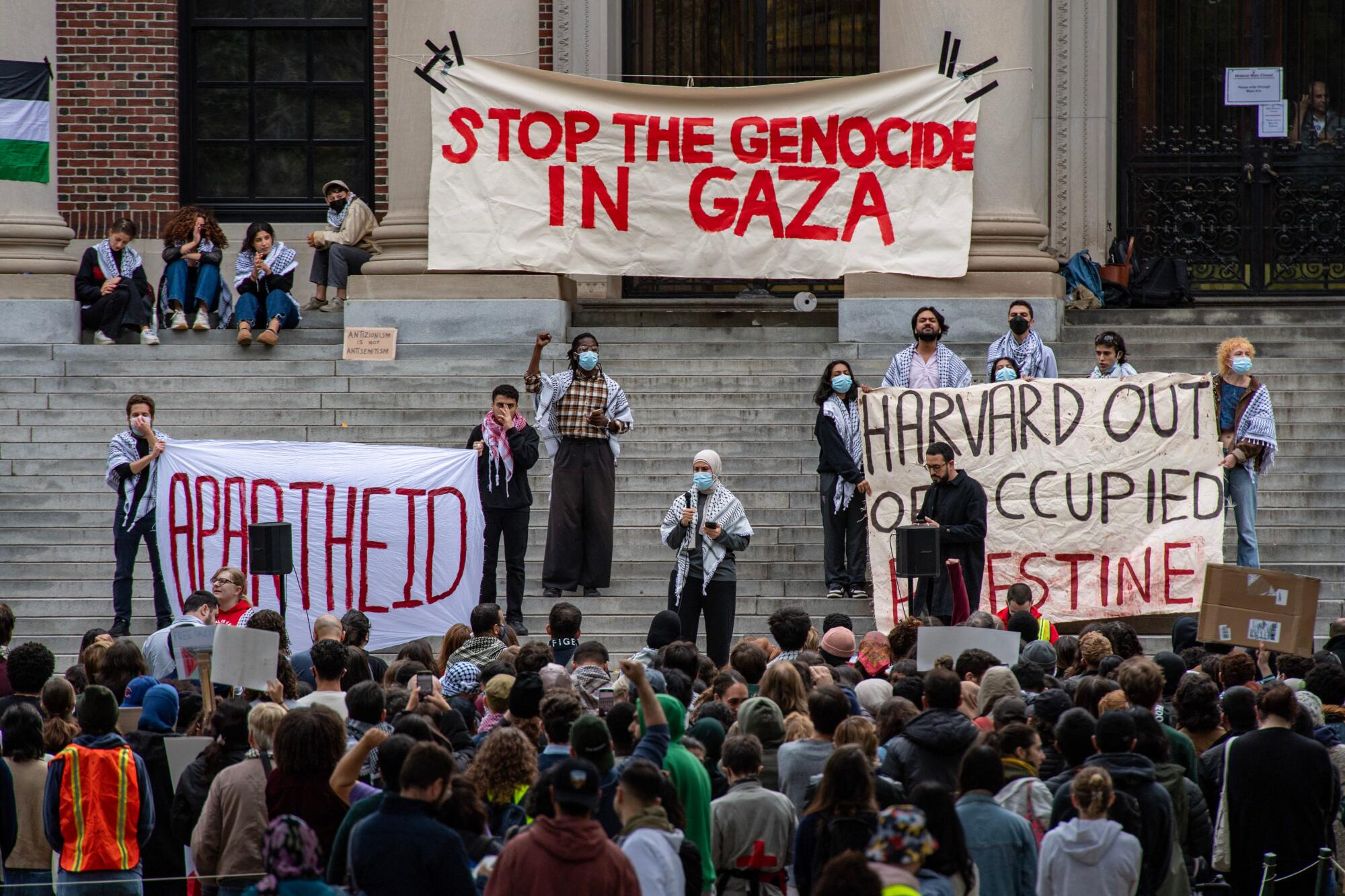
The Harvard Graduate Students for Palestine and the Palestine Solidarity Committee announced that 34 student organizations “hold the Israeli regime entirely responsible for all unfolding violence.”
A professor of modern Arab politics and intellectual history at Columbia University described the attack as “awesome.” A professor at UC Davis wrote that Zionist journalists “have houses w addresses, kids in school” and “they should fear us.” She ended her note with emojis of a knife, an ax and three drops of blood.
Waxman, 49, suddenly worried that dogmatic thinking about the Israeli-Palestinian conflict had led to a moral failing — a readiness to dehumanize all Israeli civilians as settler colonists who therefore have no right to be there, or to endorse terrorism as acceptable resistance.
“It isn’t just a question of how they might perceive and understand what’s taking place in Israel-Palestine,” he said. “But it actually seems to skew or pervert their moral responses to mass atrocities.”
Less than two weeks after the massacre, a Harvard poll of registered voters ages 18 to 24 found that 48% sided with Hamas and 51% believed the grievances of Palestinians justified the attack and the targeting of civilians.
“Some students have absolutely no ability to understand Israel in any way,” Waxman said. “They see it almost as a caricature, just this wicked, fundamentally evil place, and I think that deprives them of the ability to understand what’s actually happening.”
A forensic investigator in Tel Aviv works to reassemble remains of victims of Hamas militants, trying to understand the causes of death and the underlying cruelty.
At Columbia, Khalidi, 75, said he was encouraged by growing interest among students in the plight of Palestinians.
He led a group of professors to sign an open letter defending student activists from accusations of antisemitism after they stated the “responsibility for the war and casualties undeniably lies with the Israeli extremist government and other Western governments.”
In its response to the massacre by Hamas, Israel has leveled entire neighborhoods in Gaza and — according to health authorities there — killed more than 15,000 Palestinians.
Khalidi has denounced the Israeli invasion, but at the same time he said he is troubled by the assertion common on many campuses that unarmed Israeli civilians were legitimate military targets on Oct. 7. He called those killings “war crimes.”
He worried that students who didn’t know a lot about the conflict were undermining the cause with sloppy thinking.
When such students approach him during office hours to talk about the Palestinian cause, he tells them: “You better learn about it. You are advocating.”
Times staff writer Jaweed Kaleem contributed to this report.
More to Read
Sign up for This Evening's Big Stories
Catch up on the day with the 7 biggest L.A. Times stories in your inbox every weekday evening.
You may occasionally receive promotional content from the Los Angeles Times.
